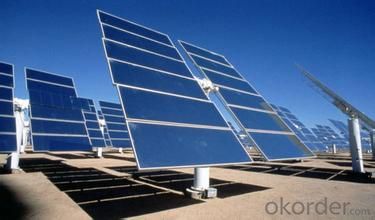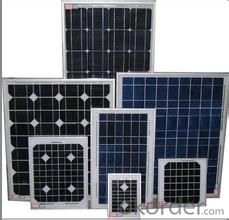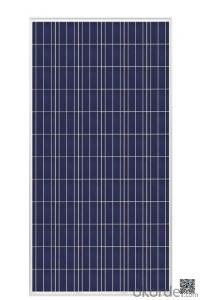LOW PRICE SOLAR PANELS,SOLAR PANEL MADE IN CHINA ,SOLAR MODULE PANEL WITH FULL CERTIFICATE
- Loading Port:
- Shanghai
- Payment Terms:
- TT OR LC
- Min Order Qty:
- 2500 watt
- Supply Capability:
- 25000 watt/month
OKorder Service Pledge
OKorder Financial Service
You Might Also Like
Item specifice
We now provide
• Monocrystalline Solar Panel
• Polycrystalline Solar Panel
Features of our products:
• High conversion efficiency mono/poly-crystalline amorphous silicon solar cells
• Modules incorporate high performance bypass diodes to minimize the power drop caused by shading
• High transmittance, low-iron tempered glass
• High performance EVA encapsulant to prevent destroying and water.
• AI frame: without screw, corner connection. 8 holes on the frame can be installed easily
• Good performance of preventing from atrocious weather such as wind and hails


Polycrystalline Silicon Solar Modules 48Cell-195W Specification
ELECTRICAL PERFORMANCE | |||
Power output | P max | W | 195 |
Power output tolerances | ΔP max | W | 0/+5 |
Module effi ciency | η m | % | 14.7 |
Voltage at Pmax | V mpp | V | 23.7 |
Current at Pmax | I mpp | A | 8.03 |
Open-circuit voltage | V oc | V | 30.1 |
Short-circuit current | I sc | A | 8.65 |
Product Description:
This installation Manual contains essential information for the electrical and mechanical installation that your must know before installing CUSTOMER PV modules. This also contains safety information you need to be familiar with .All the information described in this manual are the intellectual property of CNBM and based on the technologies and experiences that have been acquired and accumulated in the long history of CUSTOMER. This document does not constitute a warranty, expressed or implied.
CUSTOMER does not assume responsibility and expressly disclaims liability for loss, damage, or expense arising out of in anyway connected with installation, operation, use or maintenance of the PV modules. No responsibility is assumed by CUSTOMER for any infringement of patents or other rights of third parties that may result from use of PV module.
CUSTOMER reserves the right to make changes to the product, specifications or installation manual without prior notice.
Solar panel working process
In addition to being the ultimate source of all life on earth, the sun is an infinitely renewable, completely pollution-free source of electricity. Instead of burning fossil fuels dug up from the ground in a big power plant – a very 19th century, industrial age approach, when you think about it – solar panels convert sunlight directly into electricity, with no harmful emissions.
The basic unit of a solar panel is a solar cell, which usually consists of one or two layers of silicon-based semiconductor wafers. When struck by the photons in sunlight, the solar cell generates an electrical charge due to the "photovoltaic effect" – which is a pretty good name, since it produces voltage from photons. The flow of these electrons moves in a steady electrical current from one side of the cell to the other.
Dozens of these PV cells are packaged together into solar modules, which in turn are packaged into solar panels that are mounted on a rooftop and arranged to maximize their hours of exposure to direct sunlight. Because the electricity generated by all those solar cells is direct current (DC), it is then sent to an inverter that transforms the power into the same alternating current (AC) used by the appliances in your home and the local utility electricity distribution grid. Increasingly, these inverters are getting "smart," providing data monitoring for solar installation performance and other grid integration services.
- Q:Can solar panels be used for powering a museum or cultural institution?
- Yes, solar panels can certainly be used to power a museum or cultural institution. Solar panels are a sustainable and renewable energy source that can generate electricity by converting sunlight into usable power. By installing solar panels on the rooftops or surrounding areas of a museum or cultural institution, it is possible to produce clean energy that can be used to power the building's lighting, heating, cooling systems, and other electrical needs. This not only reduces the institution's carbon footprint but also helps save on energy costs in the long run. Additionally, solar panels can serve as a visible symbol of the institution's commitment to environmental sustainability, inspiring visitors and the community to embrace renewable energy solutions.
- Q:The average solar panel produces 0% of the energy that is put into it. What is happening to the other 90%? Is it being reflected or is it being obsorbed by materials that are not a part of the solar cell? Is it possible to one day have near 00% efficient solar cell technology?
- Unlikely that we gan get to near 00% efficiency, although there is room for improvement. In the meantime, don't pooh-pooh 0% efficiency. That's about the rate of energy transfer up a food pyramid, perhaps a little less at the solar to plant level. As this manages to provide the basis for most of life on earth, it's nothing to sneeze at. As far as the other 90% goes, I would guess that much of it is reflected.
- Q:Can solar panels be installed on a balcony or terrace?
- Yes, solar panels can be installed on a balcony or terrace. However, it is important to consider the structural integrity and load-bearing capacity of the balcony or terrace before installation. Additionally, the orientation and shading of the area should be evaluated to ensure maximum sunlight exposure for efficient energy generation. Consulting with a professional solar installer is recommended to determine the feasibility and safety of installing solar panels in this specific location.
- Q:Can solar panels be installed on fences?
- Yes, solar panels can be installed on fences. In fact, fence-mounted solar panels have become increasingly popular as they provide an additional space for generating renewable energy without consuming valuable land.
- Q:If not how do they give power to a house/a company?
- They are wired into the power system much like the normal power from the local power co. That is simply stated as it can be a complex system with switching cercuits and computer control. Most home systems are more simple and in many cases the solar pannels realy only charge batteies. The ones that use them directly only feed them to certain curcits while the rest run off of the local power company. Solar systems still can't supply a lot of current so it takes a bunch of them to get much usable wattage.
- Q:Can solar panels be installed on a car or electric vehicle?
- Yes, solar panels can be installed on a car or electric vehicle. These panels can generate electricity by harnessing sunlight and can be used to power certain components of the vehicle, such as the battery or air conditioning, reducing reliance on the main power source. However, due to limited surface area on cars, the amount of power generated may be relatively small compared to the vehicle's overall energy needs.
- Q:Can solar panels be installed in a remote location?
- Yes, solar panels can be installed in remote locations. In fact, remote areas with limited access to electricity grids can greatly benefit from solar panel installations. Solar panels are designed to operate independently and generate electricity from sunlight, making them an ideal solution for off-grid locations. They can be installed in remote areas such as deserts, mountains, or even on boats, providing a reliable and sustainable source of power.
- Q:Can solar panels be used in hot climates?
- Yes, solar panels can be used in hot climates. In fact, solar panels are more efficient in hot climates as they thrive in high temperatures. However, it's important to ensure proper installation and maintenance to prevent overheating and maximize their performance.
- Q:Here's a little idea I though might help everyone out in Iraq a little: How about if the US mass produces solar panels that are small enough to carry (maybe one foot by three feet) that have a regular power outlet on them to the Iraqis? We could send convoys to the people waiting in line to buy gas and give each person one free solar panel. Why?. A lot of people are buying gas to run generators for air conditioning, not to fuel vehicles. 2. It would help reduce the gas lines if people only needed gas for cars instead of their generators too.3. It would help reduce the fighting over the power grid if people didn't need the grid for their own electrical power.My theory is, once every family in Iraq has enough of these panels that they don't even care about the power grid (during the daytime anyway) it would be much easier to fix the power grid. Maybe these solar panels could even connect to and add to the power grid.
- I have a better idea . Why don't we pull our troops out of there and take the money that we spend to kill people and build a mass amount of solar cells and hand them out to our own people maybe give one of our hungry people a little food to go with it . You could even take a little of that money and put some kids through college . I can think of thousands of things to do with that cash . Why don't we ever take care of our own people first ?
- Q:What is the working principle of solar panels?
- the material is easy to industrial production and material performance and stability.
1. Manufacturer Overview |
|
|---|---|
| Location | |
| Year Established | |
| Annual Output Value | |
| Main Markets | |
| Company Certifications | |
2. Manufacturer Certificates |
|
|---|---|
| a) Certification Name | |
| Range | |
| Reference | |
| Validity Period | |
3. Manufacturer Capability |
|
|---|---|
| a)Trade Capacity | |
| Nearest Port | |
| Export Percentage | |
| No.of Employees in Trade Department | |
| Language Spoken: | |
| b)Factory Information | |
| Factory Size: | |
| No. of Production Lines | |
| Contract Manufacturing | |
| Product Price Range | |
Send your message to us
LOW PRICE SOLAR PANELS,SOLAR PANEL MADE IN CHINA ,SOLAR MODULE PANEL WITH FULL CERTIFICATE
- Loading Port:
- Shanghai
- Payment Terms:
- TT OR LC
- Min Order Qty:
- 2500 watt
- Supply Capability:
- 25000 watt/month
OKorder Service Pledge
OKorder Financial Service
Similar products
New products
Hot products
Hot Searches
Related keywords





























